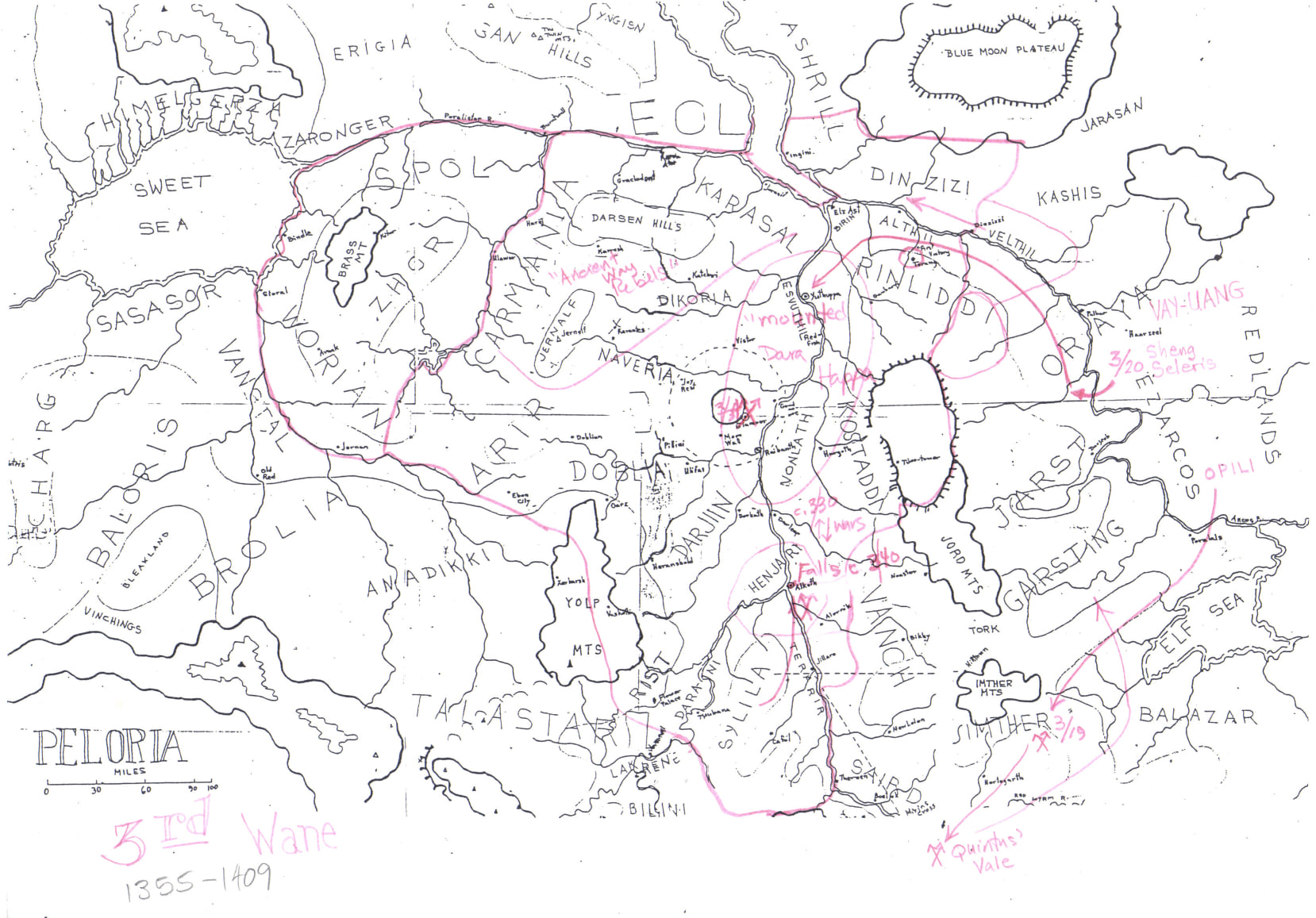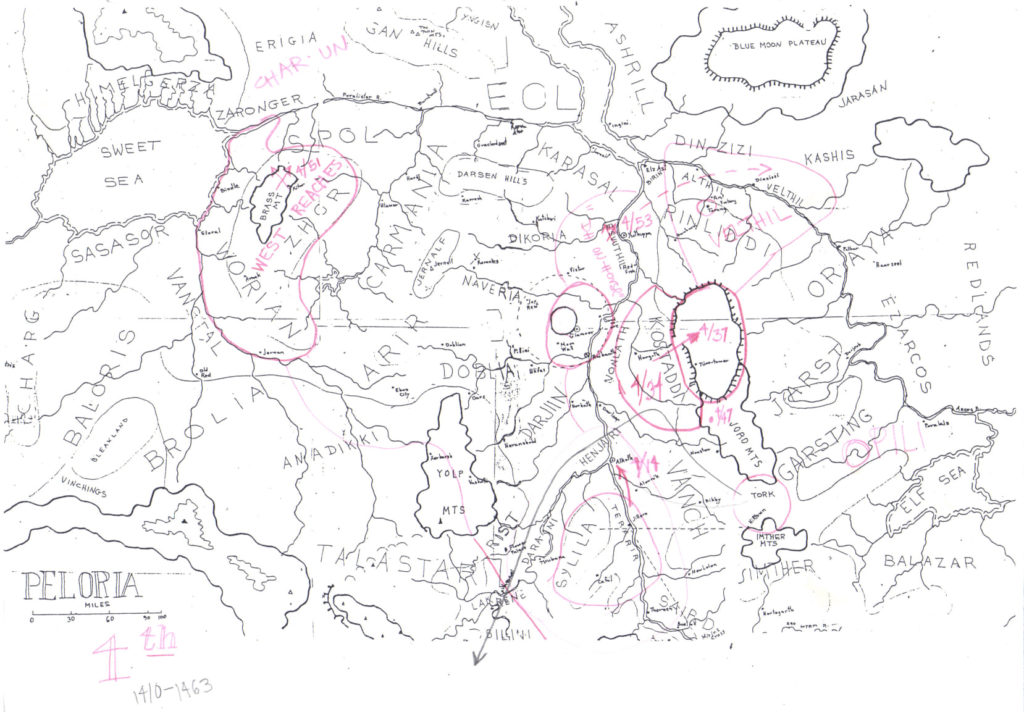So let’s contemplate Sheng Seleris, the Shadow of the Lunar Empire. Sheng Seleris and his nomad army entered Peloria for the first time in 1375. Sheng Seleris was a celestial hero, whose horses could run through the sky, and whose companions were as pure and as merciless as the light of the sky.
Sheng Seleris exploited the weaknesses of the Lunar Cycle, and with the superior mobiity of his nomadic army, he repeatedly forced battle upon the Lunar Army during the Dark or Dying Phase. For over a quarter century, the Lunar Army knew little more than defeat and humiliation. The Red Emperor maintained his claims to be the legitimate ruler of the Lunar Heartlands, but in truth his authority was confined to a few strongholds. The Red Emperor engaged in several magical contests with Sheng Seleris, but appeared to have lost them all. Much of Peloria was overrun, and many cultivated areas returned to grassland. For FOUR GENERATIONS(!), nomadic herds roamed over the Pelorian grasslands. In some areas, city and town life continued, ruled over by Yelm-worshipping horsemen. Other areas paid tribute to whatever nomad chieftain demanded it, and submitted themselves to whatever other demands were made, in exchange for limited autonomy.
In 1409, the first Temple of the Reaching Moon founded. Within the “Glowline” formed by her temples, the Red Moon was always magically at Half Phase, which helped to mitigate the Lunar magical weakness that Sheng Seleris exploited. The Lunar Army knew a few successes against the lieutenants of Sheng Seleris, although whenever Sheng Seleris was present, the Lunars were badly defeated.
In 1415, Sheng Seleris killed the Red Emperor in a magical duel. This is the first time the Red Emperor is known to have died. He had ruled for over 150 years but now was gone. For 15 years, there was no emperor.
In 1428 the Red Emperor reappeared, but was much weaker. The Red Emperor was reduced to being a guerilla leader, and he was repeated forced into hiding. In 1442, Sheng Seleris defeated the Kralorelan Emperor and became a god. A new star appeared in the heavens. The remnants of the Lunar Empire shuddered before the Celestial Empire. The Red Emperor confronted Sheng Seleris and was killed again, and Sheng Seleris flew his elite warriors to the Red Moon to search for him. The scars on the Red Moon can still be seen by the naked eye.
Sheng Seleris continued to search for the Red Emperor, and ravaged the land and mythology. He killed those who were formerly neutral in the conflict, and made a growing number of enemies. Even those who had once hated and feared the Red Goddess increasingly viewed her as the lesser threat.
In 1460, the Red Emperor returned (in a new form) and finally defeated Sheng Seleris in a magical duel the Battle of Kitor. Lunar propaganda claim this was a long-planned master scheme of the Red Emperor, but other accounts suggest it was more opportunistic and that many former enemies aided the new Red Emperor.
Over the next few years, the Lunar Army forced the now leaderless nomads to withdraw from the Lunar Heartlands into the Redlands. But the nomads were still powerful and a near-equal to the Lunar Army. The threat was not ended for another two generations with the Nights of Horror (1506), which destroyed both the Lunar Army and the nomads. The Lunar Empire raised a new army, but the nomads were forced deep into Pent.


![]()
![]()
This is so very very different from the Lunar Empire of a century and a half later.
Sheng Seleris’ game of Whack-a-Mole against the Red Emperor exhausted the Celestial Emperor and turned formerly neutral (or even potentially friendly) forces into enemies. Ironically, this sounds a lot like what happened to the Lunar Empire in the Eighth Wane.
Almost every institution we associate with the “modern” Lunar Empire except the Seven Mothers and the Red Goddess really is the result of the struggle with Sheng Seleris and the nomads. The Glowline. The Lunar College of Magic. The Cavalry Corps. The widespread nature of New Pelorian. Referring to each new Red Emperor as a “Mask” of the Red Emperor. And so on.
So before you think about the Lunar Empire, remember that it rose out of the ashes of a previous Lunar Empire, one nearly destroyed by Sheng Seleris. The Lunar Empire has known defeat and had to recreate itself out of the ruins.
